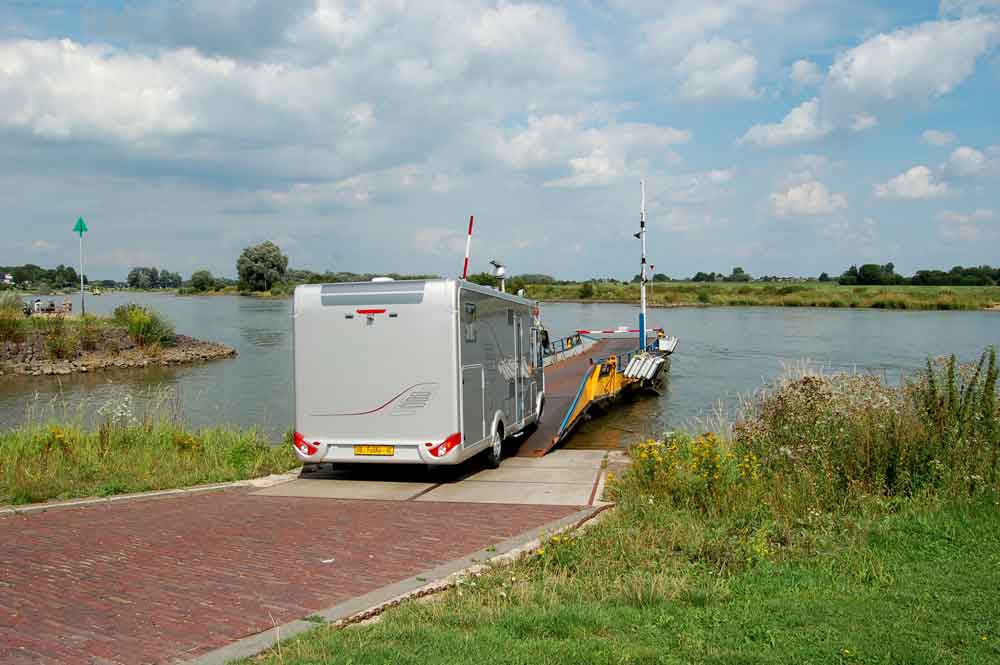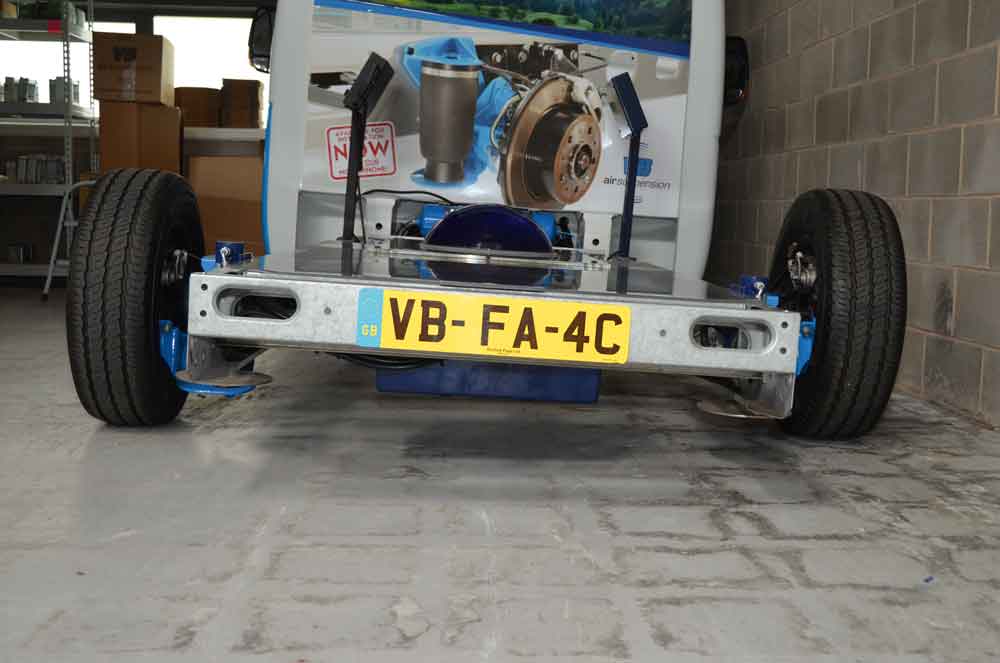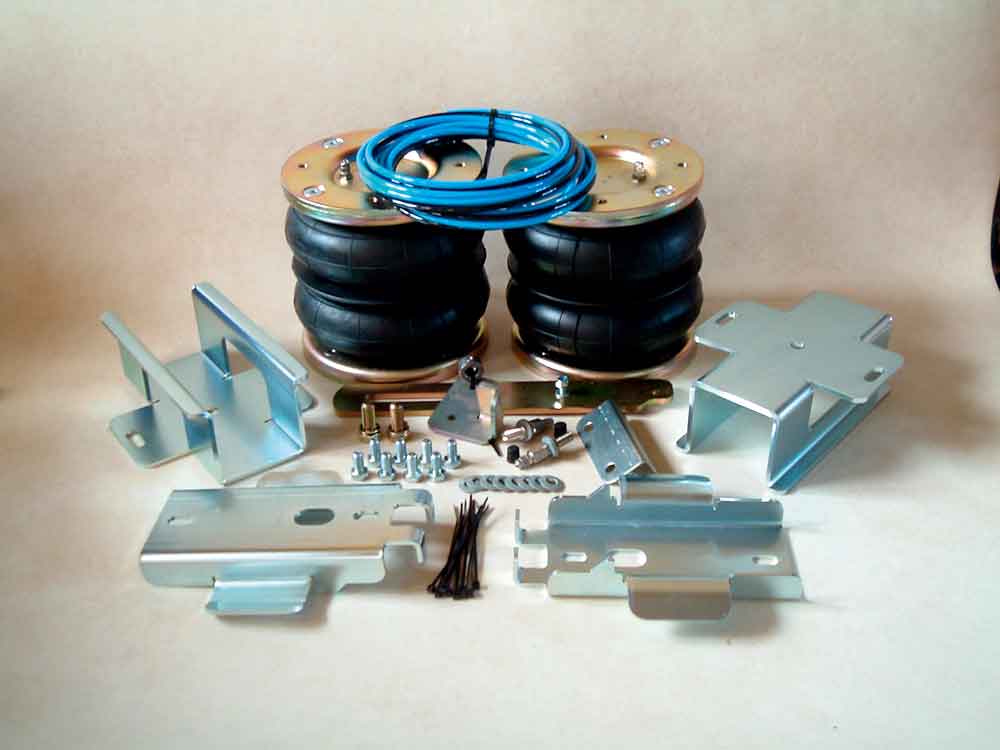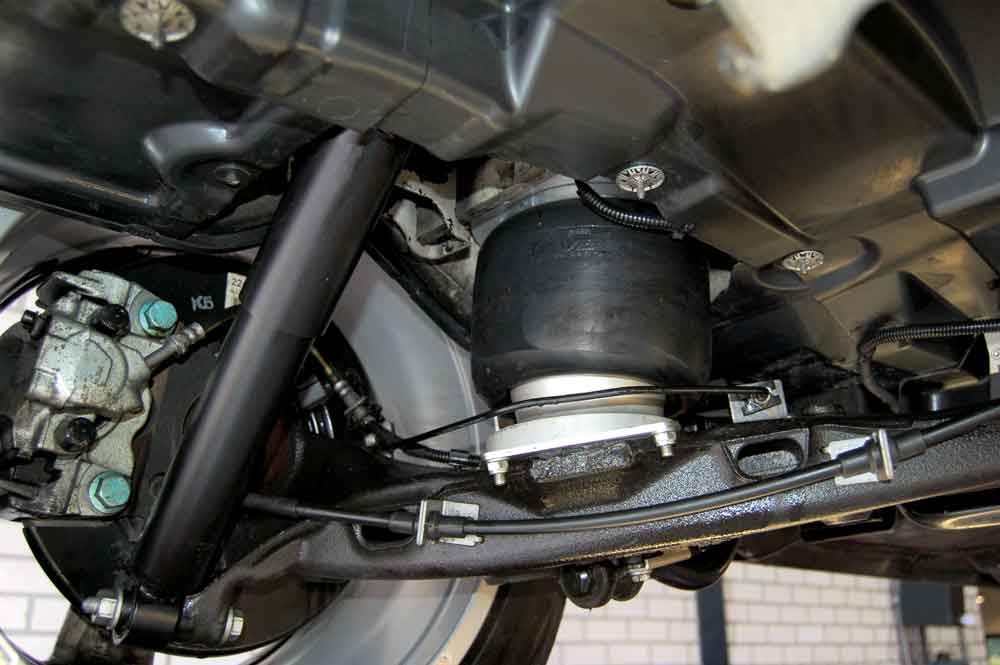Motorhome levelling and air suspension systems explained
Arriving late at a campsite and faffing about levelling the motorhome isn’t a great start to a holiday. Even worse, you could have had a journey down rutted roads and motorways with HGVs buffeting you about leaving you stressed. This is where modern motorhome levelling and suspension aids come in. They may be expensive, but they offer real benefits, many beyond their basic functions
Why you should install a motorhome levelling system
There are many benefits of installing a levelling system on your motorhome, including:
- Easy or automatic levelling on arrival at your chosen campsite
- Stability on site when moving around inside and during storms
- Improved shower tray drainage
- Facilitate waste tank emptying
- Easier wheel changing
- Removes weight from tyres and enhances security in storage.
Motorhome hydraulic levelling systems
We’re all familiar with motorhome levelling ramps but fixed hydraulic levelling systems operated by a 12V air pump are available, which, combined with modern electronic wizardry, means that just a press of a button will have your motorhome level in minutes.
The major suppliers are specialist levelling company, E&P Hydraulics; chassis manufacturer, Al-Ko; and chassis accessory company, Goldschmitt, marketed here by motorhome dealer, Travelworld. Also active in the market are Glide-Rite with UK-manufactured products and AS Air Suspension with kit from Dutch company, HPC Hydraulics.
These levelling devices consist of four chassis-mounted extending legs that are either manually or computer controlled to level the motorhome. The degree of slope a levelling system can deal with will depend on the particular bit of kit and also the length of motorhome and the available fixing points. So check first. A reasonably sized traditional levelling ramp may provide lift of about 115mm under the wheel.
Hydraulic levelling systems are likely to offer a lift far more than this depending on the system. You can, of course, supplement the legs with blocks, but you are then getting into safety concerns about stability, so don’t bank on too much blocking up.
Costs and benefits of hydraulic levelling kits in motorhomes
The price for a fully automatic hydraulic levelling kit fitted will be around £5,000 to £7,000, although (at the time of writing) Glide-Rite is offering a manually controlled system for £3,450. Either way, it’s a lot of money, but for those with limited mobility they’re ideal and there are other benefits, too.
Most of the automatic systems are capable of manual operation, meaning rather than just auto-level you can lift up one corner for changing a wheel, or maybe you have a shower that is slow to drain on the level. The operating systems of top-of-the-range models include the facility to program in additional modes such as shower draining by one touch of the button.
Then there is the ability to jack the weight of the motorhome off the tyres as recommended for winter storage and provide a significant deterrent against theft. Note, most systems are not recommended for use when working under a motorhome, so always use axle stands.
On site, some motorhomes, mainly those with long rear overhangs, can move as you walk about, which can be unsettling or, if you’re in a storm on site, your motorhome can sway dramatically. Using four sturdy legs will certainly stabilise the situation.
The disadvantage – apart from cost – can be weight. A levelling system for a 3.5-tonne ’van is likely to weigh around 55kg. Against this, you can remove the weight of existing levelling ramps, but that’s only about 5kg.
Self-levelling system fitting and maintenance
Goldschmitt does not recommend its systems for DIY fit, saying: “Self-levelling and full air suspension systems are quite complicated pieces of equipment and should only be fitted by competent trained technicians.” Automatic systems in particular need to be set up correctly and calibrated.
Most levelling companies liaise with chassis manufacturers and design jacks for attachment to original chassis mounting points. Drilling and welding of the chassis is definitely out.
Ideally, the electrical gear is best located above floor level in a locker but, where room is tight, some manufacturers can supply a watertight box for fitting under the chassis. Controls can be on a panel located at an accessible location such as a doorway, but most systems offer a handheld remote control that allows you sight of operations, particularly for manual operations like lifting for changing a wheel.
It’s normal for the system to be powered by the vehicle battery, but only when the engine is running. Hence there are no implications for draining your battery.
Manufacturers recommend their systems be checked periodically, primarily to avoid a build-up of mud on the extending jack legs, but also to apply an anti-corrosive agent. The oil reservoir level needs to be checked from time to time and the oil changed periodically in accordance with the manufacturer’s requirements.
Buying a motorhome self-levelling system
Look for safety systems where, if the legs are extended, they will automatically be retracted when the handbrake is taken off so you can’t drive off with the legs still down.
If you have a low chassis it may be necessary to use jack legs that swing up to the underfloor. However, in most cases a short barrel jack body with telescopic legs will enable the jack to fit up into a chassis, providing the necessary clearance.
An automatic system should work on a sequence, so the levelling action won’t strain or distort the chassis.
Discuss with the supplier to ensure all the facilities you need, especially the amount of lift, are available on the system you’re considering.
Systems vary between supplying companies and different systems, often dictated by the chassis it is being fitted to. Some systems have two-way hydraulics, which use hydraulic power to withdraw and apply the jacks, useful when extracting jacks from muddy or frozen ground. Systems with single hydraulics rely on spring power to retract. Even the diameter of the jack foot’s important, as the larger the diameter, the better it’ll perform on soft ground.
Remember, you can transfer a system to a new ’van if it has a similar chassis but, if you can’t, don’t expect to fully recoup your costs in the secondhand market.
Finally, investigate whether your levelling needs can be achieved with air suspension. If only one system is affordable, you need to prioritise ride comfort over on-site ease and stability.
Motorhome air suspension systems

There’s an overlap with levelling and air suspension. Full air suspension provides an ability to control level on site, albeit not always to the extent of the best hydraulic levelling systems.
At its simplest, a suspension system is designed to isolate the passengers and cargo from the harshness of road surfaces. In the days of yore, leaf springs were standard and, today, such systems are still used on the rear axle of the most common motorhome base vehicles. Leaf springs are basic but are robust and functional.
MacPherson struts are usually found on front axles. This is where a strut utilising a coil spring with integral shock absorber provides independent wheel suspension.
While it can be said the main components of a suspension system are the leaf or coil springs, modern sophisticated suspension systems also rely on an associated shock absorber and linkage systems such as anti-roll bars to provide maximum ride and handling comfort.
Campervans based on the likes of the VW Transporter will have coil spring systems on all four wheels. Motorhomes with an Al-Ko chassis will have Al-Ko’s torsion bar suspension on the rear axle; the wheel hub is attached to a swing arm and a torsion bar extending through the rear axle tube. As a rear wheel moves up or down the swing arm meets resistance to movement from the twisting of the torsion bar in the same way a coil or leaf spring flexes.
All these systems have their benefits and drawbacks, but one thing manufacturers of air suspension argue is all the existing suspension systems can benefit from replacement by air suspension. They would say that, but many independent commercial body builders also see the benefit and incorporate air suspension into their conversions, whether ambulances or passenger-carrying minibuses.

Using supplementary air suspension
Gareth Marsh, of SvTech, which is the UK’s leading technical specialist in weight re-rating of vehicles and recognised by DVLA and DVSA, recommends the use of supplementary air suspension even where there is no weight issue due to the positive ride quality gains. Clearly, there are recognised benefits from air suspension like ride comfort and road holding, but there are also additional benefits of control of static and running height and level adjustment.
Air springs are tough rubber bags or bellows inflated to a pressure and height to provide suspension. By adding an air compressor, height sensors and electronic controls, full air suspension systems can instantly control the quality of ride and handling to different load situations.
It’s important when considering systems to appreciate what’s actually on offer. Auxiliary or supplementary air suspension is a far cry from full air suspension. Full air systems replace existing suspension springs, while supplementary systems work with the existing suspension.
A full air system offers a multitude of side benefits and a greatly improved ride experience, while the supplementary system – known as air assistance – has a more limited offering, as does full air suspension on just one axle. But, don’t dismiss air assistance, as it still offers considerable ride improvements at a much lower cost than full systems.
Four good reasons for installing supplementary air suspension
- Improved road handling and passenger comfort
- Restore original ride height at rear and improve ground clearance for ferry ramps and steep driveways
- Reduced leaning from uneven loading (twin valves only)
- Restoration of rear suspension system at budget price
Fitting supplementary air suspension systems
Air assistance or supplementary air suspension systems are easy to fit as they work alongside the existing leaf spring suspension on the rear axle. A basic kit can cost as little as £350 excluding fitting and you will find many suppliers of kits and installers. Typical of these are Marcle Leisure, which specialises in the supply (no fitting) of a range of kits and spares and Airide, which supplies and fits or can just supply.

A common reason for fitting air assistance is due to onerous loadings imposed on a chassis by a motorhome. Standard commercial vehicles will, at times, be fully loaded to their designed maximum gross weight (GVW) and, equally, they will spend time empty or partially empty.
Motorhomes, though, are always close to being fully loaded on and off the road. As soon as the motorhome converter starts fitting the interior, including fridges and cookers, the springs will start to move down. The majority of motorhomes will be at or very near GVW, if not overloaded.
Original leaf spring suspension starts life well enough, but several years on, the suspension becomes tired – sometimes in overloaded situations, symptoms of flattened springs appear in as little as six months. Once springs have become tired, there is less travel and therefore much less ability to absorb shocks from the road.
It’s no wonder then that Ben Babcock, of motorhome specialist workshop, Watling Engineers, says, “Fitting supplementary air suspension to a motorhome is never a bad idea. All motorhomes are built quite close to their maximum weight limit and the original springs were never designed to work at that capacity and more for all of their lives.”
It should be noted that, where the condition of the springs is exacerbated by overloading, the weight issue has to be addressed – either reduce the weight or get the motorhome uprated. The addition of air assistance will resolve the flattened springs and reintroduce some welcome suspension travel back into the vehicle.
What it won’t do is make an overloaded axle legal. There is a formal procedure for uprating a vehicle and it is best to consult a specialist like SvTech for advice.
Air assistance doesn’t allow any great variation in level due to the constraints of the existing suspension springs, but it will eliminate rear end droop. With a dual-chamber system, the separate air lines provide independent pressures and permit a degree of compensation for uneven loading and transverse sagging.
Additional add-ons to a basic kit include pressure gauges for instant checking and an onboard compressor for convenient pressure top-ups so you don’t need to use a forecourt air line. An advantage of basic kits is the small impact on the vehicle’s payload allowance, adding as little as 8-10kg.
Six good reasons for installing full air suspension
- Improved straight line stability
- Improved cornering stability and reduce body roll
- Increased ground clearance for ferry ramps and steep driveways
- Reduced uneven wear by maintaining transverse ride height
- Reduced fatigue with increased passenger comfort
- On-site levelling and benefits for draining waste tanks and showers.
Suspension design is based on achieving the most suitable trade-off between comfort for passengers and the need to achieve good traction and accommodate load variations and the amount of axle travel. In such a complex situation, it’s little wonder some compromises are inevitable with standard commercial vehicle chassis where value for money is always key. Hence the scope for full air suspension to improve the ride comfort and handling, but the cost of an automatic full air suspension system including fitting is likely to be in the region of £5,000 to £8,000 depending on manufacturer and sophistication of controls.
Because of regular air pressure changes, automatic systems require an air pressure vessel to supply the quantity of air needed. The pressure vessel must include a drying system for incoming air to prevent a build-up of moisture in the bellows that can cause problems in freezing conditions.
Goldschmitt’s ADC full vehicle air suspension even offers a vehicle weigh facility, though all this sophistication not only adds to cost but weight.
DriveRite, which manufactures full and supplementary kits, shows just the IntelliRide control kit of its top-of-the-range 4C full air suspension system as weighing in at 23kg. A full four-corner air suspension system on a standard Fiat Ducato chassis is likely to weigh up to 60kg, depending on what kind of leaf springs are removed. So watch your payload.
A huge advantage of full 4C air suspension systems, in addition to improvements in road holding and comfort, is the ability to vary levels significantly when static. Front seat passenger and driver are also said to receive greater levels of comfort, because for the likes of a Fiat Ducato, the front seats are almost directly located over the suspension system.
Fitting full air suspension to the rear axle only (2C) will reduce the benefits, particularly for on-site levelling, but will improve ride, the ability to keep up the rear end when using ferry ramps and achieve level ride height across the rear wheels.
Even the VW T5 and T6 chassis is said to be improved by the addition of full air suspension. Two attributes campervan owners with full air suspension enjoy are the ability to have a lower ride height – perfect to creep under height barriers – and also to raise the vehicle for off-road access.
Latest developments
When a full air suspension system is fitted on the rear axle, the existing shock absorbers are normally replaced for ones designed to work specifically with the air bellows being fitted. Standard shock absorbers or dampers are as strong when driving straight ahead with an empty vehicle as when making evasive manoeuvres at high speed when fully loaded.
Now VB-Air-Suspension offers an adaptive shock absorber called VB-ActiveAir. This can adapt its damping force according to conditions automatically in six milliseconds. The combination of air suspension and ActiveAir is claimed to provide significantly less body movement and improve braking by up to 15%. Costs are anticipated to be in the region of £5,000 to £6,000.
Fitting and maintenance
Goldschmitt, VB-Air-Suspension and Al-Ko do not recommend DIY fit for their systems because the quality of the installation, set-up and calibration of the system is critical to safety and overall effectiveness of the upgrade to full air suspension.
However, VB-Air-Suspension and the other companies that supply the simpler air assistance systems are happy to supply these for DIY fit.

There’s a big difference between fitting air bellows to assist an existing suspension system and removing original equipment to replace it with air suspension. Removing original suspension equipment has implications for safety and insurance and, as Watling Engineers points out, if the vehicle is old, removal of original suspension can be quite a task.
Marcle Leisure considers its air assistance kits to be simple enough to fit for anyone who can change a wheel. If fitting full air suspension or air assistance on an older chassis without ABS braking (generally pre-2002 for Fiat Ducatos) a word of warning about front and rear brake equalisation. The pre-ABS equalisation system equates a low rear with heavy loading; with air suspension providing a constant height, the system must be adapted.
Suppliers say air suspension is maintenance free. Marcle Leisure provides a five-year guarantee for the bellows it sells, which gives a good indication of longevity.
Al-Ko’s full air suspension systems are not designed for the aftermarket, but are offered as optional extras on Al-Ko chassis by several motorhome manufacturers, such as Swift. Aftermarket suspension by Al-Ko is limited to its Air Top (air assistance product) for the rear axle of Fiat Ducato X250 chassis and a sophisticated shock absorber for its torsion axle chassis.
Buying tips for air suspension systems
As with levelling systems, check with the supplier that all the facilities you require are available. A full air suspension system with automatic static levelling should work on a sequence so there’s no strain or distortion to the chassis. For manual operation this is something to be careful of.
Systems vary; in particular, note the difference between the basic air assistance kits. In general, the more you pay the greater the sophistication and the ease of use.
Some companies have a national network of service agents, which can be convenient for installation and any after-fitment problems.
Check if the kit has approval certification from recognised testing bodies like TÜV. As with any vehicle modifications, you should notify your insurance company.
If you have a shaky ’van, because of a long rear overhang, remember air suspension will not improve static stability. You can add on hydraulic levelling but always ensure the levelling and suspension control systems are compatible.
If air suspension provides all your needs except the rear end stability, then the most economical solution can probably be achieved with Al-Ko’s ClickFix rear steady legs.
Full air suspension offers a wide variety of benefits both on the road and when static on a site. The benefits of air assistance are more limited. So, it’s all a matter of your individual requirements, your budget and available payload.
Glossary
Terms vary with each manufacturer but the following are some common terms used
- Supplementary, auxiliary, semi-air suspension or air assistance – air suspension that works in conjunction with original leaf spring suspension
- Full air suspension – this replaces the original coil, leaf or torsion spring suspension. It may be used to describe a system for front and rear axles or simply a full system on a single axle. This may be indicated as full 4C (4 corners, hence both axles) or full 2C (2 corners, hence one axle)
- Dual chamber – for an auxiliary system on a single axle, indicating the air spring on each end of the axle can be pressurised independently
- Manual operation – can be as basic as a single Schrader valve without a pressure gauge using a forecourt inflator to inflate both air bags to a common pressure
- Semi-automatic operation – the system is powered by an on-board compressor so the ride height can be adjusted by the driver on demand
- Fully automatic – sensors are located at each air spring and information is fed back to an electronic control unit (ECU). The ECU maintains a level ride height despite payload changes by automatically adjusting the pressure in each air spring accordingly
Contacts
Airide Tel: 01202 632488
Goldschmitt Tel: 01952 586888
AS Air Suspension Tel: 01925 740666
DriveRite tel: 00353 18 612632
E&P Levelling Tel: 01254 297785
Glide-Rite Tel: 01428 751711
Marcle Leisure Tel: 01531 660797
VB-Suspension Tel: 01254 848010
Roseisle Tel: 0131 6535023











Recent Updates
Engine management lights: all you need to know
What is the engine management light? What does it mean, and what do I have to do? ...
Motorhome air suspension: all you need to know
Motorhomes are heavy and the additional weight of equipment and height of the bodywork can increase the loads ...
Motorhome WiFi: how to get better motorhome internet
Staying connected on the move is more and more essential, so relying on campsite WiFi isn't an option – here ...
A class of their own - our guide to A-class motorhomes
Thinking of trading up to an A-class, or even going straight to the top of the motorhome tree? We guide you ...
Explore overseas on a motorhome dream tour
Enjoy exotic travel in a campervan or motorhome by hiring, swapping with someone else or exporting your ...
Motorhome water systems: everything you need to know
On-board water is an important part of every motorhome – here’s everything you need to know ...
Campervanning in Europe: what you need to know
Whether you're planning a leisurely drive through the French countryside, navigating bustling city streets in ...
Campervan security: all you need to know
With thefts on the increase, it’s important to know how to keep your campervan secure and prevent campervan ...
Campervan furniture: everything you need to know
Our campervan experts guide you through all the essentials for your campervan, including tables, chairs, ...
Campervan finance: how to fund your purchase
Here we look at the different types of campervan finance available, to help you decide what’s the best option ...
Other Articles
Britain’s best used motorhomes
Want a great motorhome without paying the premium for a new one? Here's a guide to the best you can get in the pre-owned market for each layout, ...
Which motorhome? Choosing the perfect motorhome for you
Choosing a motorhome or campervan is one of the biggest buying decisions you’ll ever make, so it's important ...
Campervan washroom essentials: stay fresh on the road
Our guide will take you through the campervan washroom essentials you'll need so you're well-prepared for ...
Dogs in campervans: all you need to know
Follow our advice and your dog will enjoy campervanning as much as you do ...
Electric campervans: all you need to know
Our guide will take you through everything you need to know about electric campervans and what the future ...
Motorhome electrics: a complete guide to your motorhome electrical set-up
Motorhome electrics can dramatically enhance the convenience and comfort of your vehicle – but they can be ...
Lighting for campervans: all you need to know
We guide you through all the lighting options available for you and your campervan, including interior ...
Electric bikes for motorhomes: our ultimate guide
Read our comprehensive guide to electric bikes for motorhome owners, helping you add electric power to your ...
Our guide to 'cheap' motorhomes in 2024
If you're on the hunt for an affordable new motorhome, this is the best place to start – we've rounded up a ...
Campervans in winter: all you need to know
Here's your guide to preparing your campervan for the colder months, whether you will be using it or putting ...